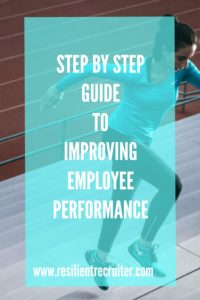Resilient Recruiter is an Amazon Associate
Terminating an employee is a very emotional task for both an employer and the person losing his or her job. In my previous articles, How to Terminate an Employee the Right Way Part #1 and Part #2, we discussed methods for parting ways with dignity and respect.
But what if the employee didn’t have to be fired after all? Most of the comments I received included statements such as “if I could do it all over again, I would have worked harder with the employee to set them up for success.” How do you set a struggling employee up to succeed?
Enter the Performance Improvement Plan, often referred to as a PIP. The Performance Improvement Plan, when structured correctly, is a collaborative tool used by both a manager and employee to identify issues or behaviors in question, establish an attainable set of goals, and measure improvement. This is a document that should be developed collaboratively, and provide a clear outline for modifications (and subsequent consequences if the modifications are not completed).
What does a Performance Improvement Plan look like, and what should it include?
Identify the Problem in Question
The first step is to identify the problem in question. The problem may be a violation of company policy, an inappropriate behavior, or underperformance of daily tasks. Regardless of the infraction, it needs to be addressed in a consistent manner. The issue should be documented in an objective manner, outlining the facts and details of the violation. Creating a form that is used consistently for Performance Improvement further reinforces objectivity.
Download Our FREE Performance Improvement Plan Template Here
When creating a Performance Improvement Plan, you should follow some key guidelines:
- Highlight examples of the violation/behavior, and address the specific policy the action is in violation of. This ensures that the employee does not feel targeted or discriminated against. Be sure to include dates of the actions in question, as well as examples of actual performance, if it is subpar in comparison to expected performance. Creating consistent reinforcement of policies and procedures fosters acceptance of consequences, and improves morale overall.
-
Speak directly to the employee about the concern(s). This is not the type of news you want to deliver via email. As always, ensure that this is delivered in a calm, objective manner, and in a private location, so that it is not within earshot of other employees. Explain that you want to work to create a successful outcome, not humiliate the employee.
Put the Performance Improvement Plan into Action
Now that the consistent guidelines are established, the Action Plan must be executed. The Action Plan should include the following components:
- Clear, Measurable Goals: This should include specific metrics when possible, to clarify expected results. If the issue is timeliness, include the specific times involved. Be sure to avoid any generalized terms, or other descriptions that could be interpreted any way other that what you intend.
-
Timeframe that the Goals are to be Achieved: Again, be sure to be clear in your expectations, and continue to monitor progress. If you hope to achieve consistent improvement, don’t expect to “set it and forget it”. If the employee has strayed off track, he or she will require continuous progress monitoring and positive reinforcement for achievements.
-
Consequences for Non-Compliance: Just as there needs to be a target goal, there also need to be consequences when the goals are not met, or the behavior is not modified. Have clear, specific actions for completion of all targets. Do not leave any generalizations here!
- If the employee will be terminated for lack of compliance, you need to state this as an understood consequence
- If the employee will be demoted or reassigned, state it in writing
- Documentation of consequences are key!
- If the employee will be terminated for lack of compliance, you need to state this as an understood consequence
**Be sure to discuss the plan with the employee and ensure full understanding. A signature reinforcing understanding of the requirements would be advisable. This could become a legal document in the future, so be sure to cover all details thoroughly.
The Follow Up
A Performance Improvement Plan typically has a time frame – 30, 60, or 90 days for improvement of behavior, or satisfaction of certain requirements that were clearly outlined in the plan. Once one (or both) are complete, it is time to follow up and determine the success of the protocol.
- Arrange an In-Person Meeting with the Employee: Again, this needs to be a private meeting where the person feels comfortable and not put on the spot. There should have been regular progress meetings throughout the process, so hopefully a level of rapport has been established.
- Review Documented Metrics: This should have been tracked throughout the process in order to create accountability, so there should not be any surprises as to the results.
- Provide Feedback and Answer Questions: This is the time to discuss your observations, as well as successes, failures, and lessons learned.
- Follow Through on Consequences: This could be positive or negative, but needs to be consistent among all employees. If the outcome is a positive one, reinstate any privileges and responsibilities that may have been revoked. If the outcome is negative, be sure to remain true to your word, as difficult as it may be.
Conclusion
Now is the time to take a hard look and assess the effectiveness of the plan. Were your goals realistic and obtainable? Did the employee grow from the experience? Did you grow? No one is perfect – sometimes the problem is with the plan and not the employee’s efforts. This is something that you need to determine and alter your company’s plan accordingly.
How does your company handle violations of policies? What is your take? I would love to hear from you! Please contact me at: nlemons@resiliencegroup.net.
by Natalie Lemons
Natalie Lemons is the founder and President of Resilience Group, LLC, author of The Resilient Recruiter, and Co-Founder of Need a New Gig. She specializes in the area of Executive Search and Career Coaching and services a diverse group of national and international companies, focusing on mid to upper-level management searches in a variety of industries. For more articles like this, follow her blog.



I’m glad I’m not in a position to where I would need to implement these techniques if an employee were not performing well, however, it’s good to know what steps should be taken if there is a problem in the office.
All supervisors should go through training that share this information. Feedback is so essential. I like to know when I am doing good and when I am doing bad. Don’t just jump on me for the bad because it makes it harder to look forward to doing the good. I appreciate this post and maybe this will help me in my weaknesses.
Very useful advice here!
Thanks, Mary! I tried to stick with some universal principles :). The law even varies from state to state here in the U.S.
Great advice here, thanks for sharing. THe UK law is slightly different but the principles of your improvement plan are required before considering termination.